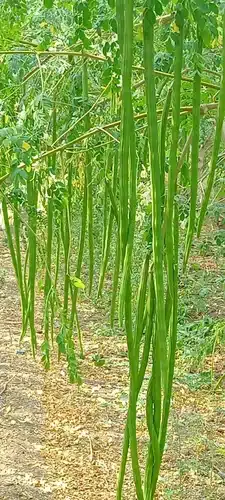Terminalia bellirica Baheda tree seeds
Terminalia bellirica Baheda tree seeds
Quantity: 30+ seeds
Buy Terminalia Bellirica (Baheda Tree) Seeds Online in India – Grow the Medicinal and Ornamental Baheda Tree
The Terminalia Bellirica, commonly known as the Baheda Tree, is a medicinal tree native to the tropical regions of India and Southeast Asia. Famous for its therapeutic properties, Baheda is a crucial herb in Ayurveda. The tree is also valued for its ornamental appeal, providing shade, and its fragrant flowers make it a perfect addition to gardens, parks, and roadsides. Growing your own Baheda Tree can provide you with a sustainable source of medicinal benefits and aesthetic beauty.
How to Plant Terminalia Bellirica (Baheda Tree) Seeds?
Follow these simple steps to grow your own Baheda Tree from seeds:
- Seed Preparation: Soak the Terminalia Bellirica seeds in warm water for 24-48 hours to soften the hard seed coat and improve germination rates. Terminalia bellirica Baheda tree seeds.
- Planting: Choose a sunny location with well-draining soil. Plant the seeds about 1-2 inches deep and space them adequately to allow the tree to grow to its full size.
- Watering: Keep the soil moist during the germination phase. Once the tree is established, it becomes drought-tolerant and needs minimal watering.
- Care: Apply organic fertilizers to support healthy growth. Prune the tree as needed to maintain its shape and remove dead or damaged branches.
- Flowering and Fruit Production: The Baheda Tree will start to bloom in white or yellow flowers and produce fruits after a few years. These fruits can be harvested for their medicinal uses.
Terminalia bellirica Baheda tree seeds
Out of stock
Terminalia bellirica Baheda tree seeds
Buy Terminalia Bellirica (Baheda Tree) Seeds Online in India – Grow the Medicinal and Ornamental Baheda Tree
The Terminalia Bellirica, commonly known as the Baheda Tree, is a medicinal tree native to the tropical regions of India and Southeast Asia. Famous for its therapeutic properties, Baheda is a crucial herb in Ayurveda. The tree is also valued for its ornamental appeal, providing shade, and its fragrant flowers make it a perfect addition to gardens, parks, and roadsides. Growing your own Baheda Tree can provide you with a sustainable source of medicinal benefits and aesthetic beauty.
Why Choose Terminalia Bellirica (Baheda Tree) Seeds?
1. Premium Quality Seeds for Healthy Growth Our Terminalia Bellirica seeds are sourced from healthy, mature trees, ensuring high germination rates and vigorous growth. These seeds are carefully packed and shipped to ensure they arrive in perfect condition, ready for planting.
2. Medicinal Benefits of Baheda Baheda is widely recognized for its medicinal properties, particularly in traditional Ayurvedic medicine. The fruits of the tree are known to have anti-inflammatory, antioxidant, and digestive benefits. The tree is often used to treat ailments such as cough, digestive issues, and skin disorders. By growing your own Baheda tree, you can access fresh Baheda fruits for your health needs.
3. Ornamental Value Besides its medicinal value, the Terminalia Bellirica tree is also an attractive addition to any landscape. It grows tall with a dense canopy, providing ample shade. The fragrant white or yellow flowers bloom in clusters, making it a beautiful tree for gardens, parks, and roadside plantations.
4. Low Maintenance and Hardy Once established, the Baheda Tree is low-maintenance and can thrive in a variety of soil types and climatic conditions. It is a drought-tolerant tree, making it ideal for tropical and subtropical climates across India. It requires little care after planting, making it perfect for gardeners looking for a hassle-free, sustainable tree.
5. Environmental Benefits The Terminalia Bellirica tree also provides environmental benefits, such as soil conservation, reducing erosion, and enhancing biodiversity. It helps in improving the soil quality, and its dense foliageoffers habitat to various birds and insects.
How to Plant Terminalia Bellirica (Baheda Tree) Seeds?
Follow these simple steps to grow your own Baheda Tree from seeds:
- Seed Preparation: Soak the Terminalia Bellirica seeds in warm water for 24-48 hours to soften the hard seed coat and improve germination rates. Terminalia bellirica Baheda tree seeds.
- Planting: Choose a sunny location with well-draining soil. Plant the seeds about 1-2 inches deep and space them adequately to allow the tree to grow to its full size.
- Watering: Keep the soil moist during the germination phase. Once the tree is established, it becomes drought-tolerant and needs minimal watering.
- Care: Apply organic fertilizers to support healthy growth. Prune the tree as needed to maintain its shape and remove dead or damaged branches.
- Flowering and Fruit Production: The Baheda Tree will start to bloom in white or yellow flowers and produce fruits after a few years. These fruits can be harvested for their medicinal uses.
Why Buy from Us?
1. Fast and Secure Delivery Across India We offer quick shipping of Terminalia Bellirica seeds to all parts of India. Our seeds are packed with care to ensure they arrive in perfect condition, ready for planting and growing into healthy trees.
2. Affordable Pricing Our Baheda Tree seeds are offered at competitive prices, making it easy for gardeners, farmers, and enthusiasts to grow their own medicinal trees. Discounts are also available for bulk orders.
3. Expert Gardening Support We provide expert guidance on how to grow and care for your Terminalia Bellirica (Baheda Tree). From planting tips to medicinal uses, we are here to support you in every step of the way to ensure the successful growth of your tree.
Benefits of Growing Terminalia Bellirica (Baheda Tree)
- Medicinal Benefits: The Baheda fruit is highly valued in Ayurveda for its anti-inflammatory, digestive, and antioxidant properties. It is used to treat a wide range of health issues, from cough and cold to skin problems.
- Ornamental Appeal: The Terminalia Bellirica tree is an attractive addition to any landscape, with its dense foliage, shade-providing canopy, and beautiful fragrant flowers.
- Low Maintenance: Once established, this tree requires little care. It thrives in tropical climates and can withstand drought conditions, making it perfect for Indian weather.
- Environmental Benefits: The Baheda Tree plays a significant role in soil conservation, improves soil health, and helps reduce soil erosion.
- Shade and Aesthetic Value: The Baheda Tree provides shade in hot climates and adds beauty to your garden, making it ideal for parks, streets, and home gardens.
Buy Terminalia Bellirica (Baheda Tree) Seeds Today!
Ready to grow a Baheda Tree in your garden or landscape? Order your Terminalia Bellirica seeds today and enjoy the medicinal properties, beautiful blooms, and low-maintenance care that come with this incredible tree.
Order now for fast delivery, affordable pricing, and expert support!
Terminalia bellirica Baheda tree seeds
| Weight | 60 g |
|---|---|
| Dimensions | 11 × 8.5 × 11 cm |







Reviews
There are no reviews yet.